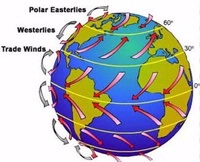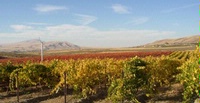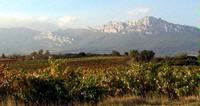|
|
 |

Wine fanciers often speak of the beneficial “rain shadow” effect in their favorite winegrowing regions. When you study the world’s wines, you find the rain shadow words mentioned in regard to Eastern Washington, Alsace, Mendoza and more. In it’s simplest form, it just means that there is a mountain range that forces air upward, causing it to drop its moisture content on the windward side and leaving drier air on the leeward side of the range. The incessantly quizzical among us will wonder why this favorable circumstance occurs.
A rain shadow requires that there be moisture and also that winds move consistently in one direction, so that the topography offers a constant protective element. This raises the question of why winds move in a consistent direction. The answer is explained by the Coriolis Effect. The earth is a rotating sphere and its rotation, combined with other factors causes large prevailing belts of wind around the globe.
If the earth were a fixed body rather than a rotating one, the heat of the sun would cause air to flow from the equator toward the poles. Hot air rises at the equator and moves poleward, creating a low pressure area in its wake. Colder, higher pressure air, then moves toward the equator to fill the void and restore equilibrium. Without rotation, there would be a single circulation cell between the equator and the pole in the northern hemisphere.

The Three Convection Cells from the Equator to the Pole
The earth’s rotation, however, combined with the 23 degree tilt of the earth on its axis, causes a much more complex situation. Because the earth is a rotating sphere, the speed at which the surface moves varies. The circumference of the earth at the equator is around 24,900 miles and completes one rotation in 24 hours -- a speed of 1,037 miles per hour. At 40 degrees of north -- the approximate latitude of Philadelphia, Columbus OH, and Denver -- the circumference is 19,014 miles, so a point on the earth’s surface travels at 792 miles per hour to complete a rotation in one day. At the pole, the speed is zero and a point simply spins. The variable speed of rotation causes three distinct air convection zones in the hemisphere instead of one.
The atmosphere is not attached to the earth, but is dragged along somewhat inefficiently by friction as the earth rotates. Even so, if an air mass flows north from the equator, it will not arrive at a point due north of its origin because the earth beneath it has moved. Since the earth’s rotation is from west to east, in the northern hemisphere, the apparent deflection of the air will be to the right. It all becomes quite complex, but the result is that at 30-60 degrees of latitude, the prevailing winds are from the west. Since most winegrowing areas lie within this latitudinal belt, they are affected by the prevailing westerlies.

Global Wind Belts and Convection Cells
Now that we have established the reason why the Prevailing Westerlies prevail, we can look at the other factors needed to create an effective rain shadow. The most obvious ones are montane barriers. Air masses cool and expand as they rise in altitude and, conversely, warm and compress as they descend. In the U.S.A., the Cascade Mountains of Washington are a splendid example of the phenomenon. Moisture laden air masses are borne by the prevailing winds off the Pacific Ocean. When they come to the volcanic mass of the Cascades they are pushed upward, cooling by up to 5°F per thousand feet as they go. At 68° F (20°C) a kilogram of air can hold 15 grams of water. At 32° F (0° C), however that same kilogram of air can hold only 3.8 grams of water. The excess water either condenses and becomes clouds or drops out as precipitation. The difference in precipitation between the west and the east side of the Cascades is huge. While Seattle averages 38 inches of rain per year, Snoqualmie Pass -- around 50 miles east -- receives 105 inches of rain per year. Travel another 50 miles east from Snoqualmie and the town of Ellensburg averages only 9 inches per year. The rain shadow effect is dramatic, indeed.

Arid Landscape of the Yakima Valley
Around the wine world, we find the warm and dry air in the leeward side of mountain barriers often provides a beneficial habitat for wine grapes. The Vosges Mountains of eastern France provide Alsace with the sunniest weather in the nation. The Southern Alps of New Zealand’s South Island shelter and warm the vineyards of Central Otago. Perhaps the most dramatic rain shadow of the wine world is the high peaks of the Andes, which block Pacific storms and moisture from the vines of Mendoza in Argentina.

Sierra de Cantabria Mountains Shelter the Rioja Vineyards
There are many other examples of rain shadows that are not quite as dramatic as these. The Langhe and Monferrato Hills of Italy’s Piedmont benefit from the rain shadow of the Alps. The Sierra de Cantabria Mountains provide protection for the vineyards of Rioja as do the Santa Lucia Mountains for the vines of the Santa Lucia Highlands and Salinas Valley. In Australia, the Great Dividing Range shelters the inland sites of New South Wales and Victoria. The vines that carpet Marlborough’s Wairau Valley yield the majority of New Zealand’s Sauvignon Blancs and are offered a beneficent climate by the rain-shadow inducing Richmond Range and Spenser Mountains to the west. Wherever you go in the wine world, there are special physical circumstances that provide beneficial impacts for noted winegrowing regions. Rain shadows are an important one, but only part of the fascinating puzzle.
|
 |
|